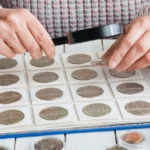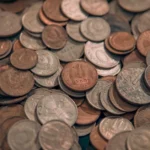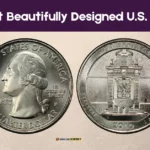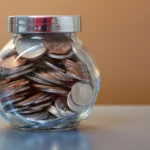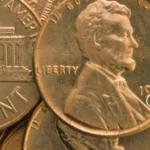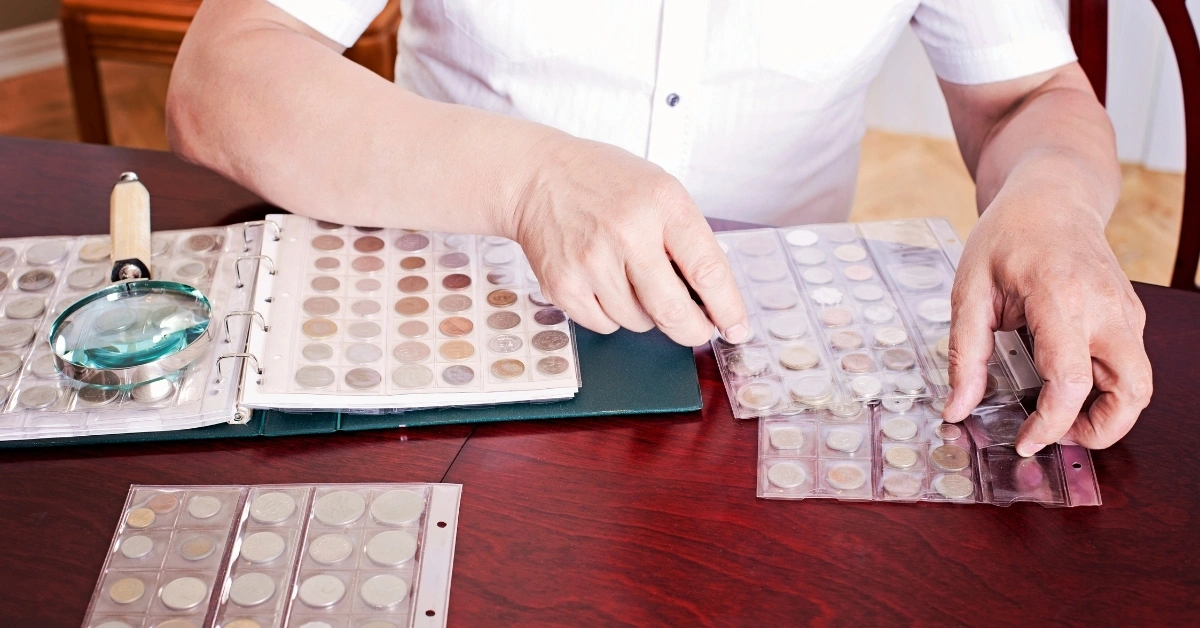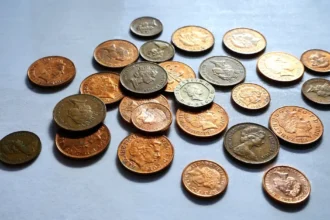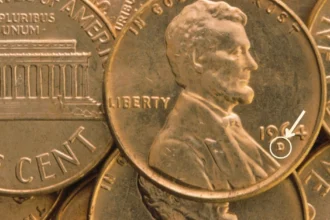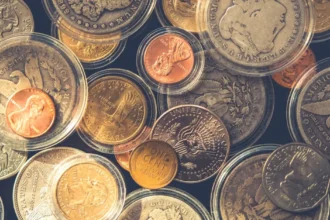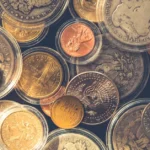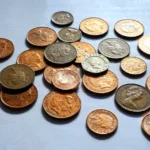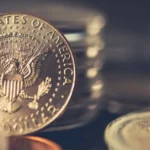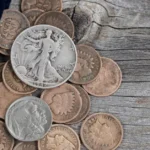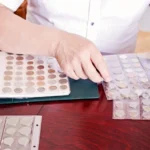Top 8 Affordable Coins to Begin Your Collection
Coin collecting, often called numismatics, is more than just a hobby—it’s a journey through history. Each coin tells a story, reflecting the culture, art, and events of its time. Whether you’re a history buff, a treasure hunter, or someone looking for a relaxing pastime, coin collecting offers something for everyone.
For beginners, this hobby is both rewarding and affordable. Many collectible coins can be found for a fraction of the price you’d expect, making it an accessible entry point for anyone curious about the world of coins. From rare mint errors to everyday designs, starting a collection is easier than you might think.
In this guide, we’ll Discuss about the 8 budget-friendly coins that are perfect for new collectors. These coins are not only affordable but also widely available, giving you the chance to build a meaningful collection without putting much money in them.
Why Coin Collecting is Perfect for Beginners
Coin collecting is an ideal hobby for beginners because it offers a unique blend of education, affordability, excitement, and potential financial rewards.
Educational Value
Coins are tiny time capsules that provide a window into history, geography, and economics. Each coin tells a story:
- Learn about historical events commemorated on special editions.
- Explore the geography of nations through coins from around the world.
- Understand economic trends, such as the transition from precious metals to modern alloys. As you build your collection, you’ll deepen your knowledge and appreciation of the past.
Affordable Entry Point
You don’t need a fortune to start collecting. Many beginner-friendly coins can be found for a few cents to a few dollars.
- Common U.S. coins like Lincoln Wheat Pennies or Jefferson Nickels are inexpensive yet rich in history.
- Bulk coin lots or thrift stores often yield interesting finds at minimal cost. This affordability makes coin collecting accessible to hobbyists of all ages and budgets.
Investment Potential
While coin collecting is primarily about enjoyment, it also offers the potential for financial gain.
- Some coins, especially rare or error coins, can appreciate in value over time.
- Precious metal coins, like silver or gold editions, hold intrinsic value tied to market trends. Although not guaranteed, the potential for a return on your investment adds an extra layer of appeal.
Accessible for Everyone
Starting a coin collection doesn’t require specialized tools or extensive knowledge.
- Many collectible coins are already circulating in your pocket change.
- Thrift stores, estate sales, and bulk coin sellers offer affordable ways to expand your collection. With so many avenues to explore, anyone can dive into the world of coin collecting without barriers.
List of Best Budget-Friendly Coins for New Collectors
If you’re just starting your coin collection, affordability and availability are key. Fortunately, the world of coin collecting offers a variety of options that won’t strain your budget. From iconic U.S. coins steeped in history to intriguing foreign coins that tell global stories, there’s something for every budding numismatist.
1. Lincoln Wheat Pennies (1909–1958)
2. Jefferson Nickels (1938–Present)
3. Roosevelt Dimes (1946–Present)
4. Washington Quarters (1932–Present)
5. Mercury Dimes (1916–1945)
6. Buffalo Nickels (1913–1938)
7. Indian Head Pennies (1859–1909)
8. Morgan Silver Dollars (1878–1921)
In this section, we’ll explore eight affordable coins that are perfect for beginners. Each coin on this list is widely available, has historical or cultural significance, and is an excellent entry point into the fascinating world of numismatics. Whether you’re searching through pocket change or visiting coin shows, these coins are easy to find and fun to collect.
1. Lincoln Wheat Pennies: One of the Best Affordable Coins
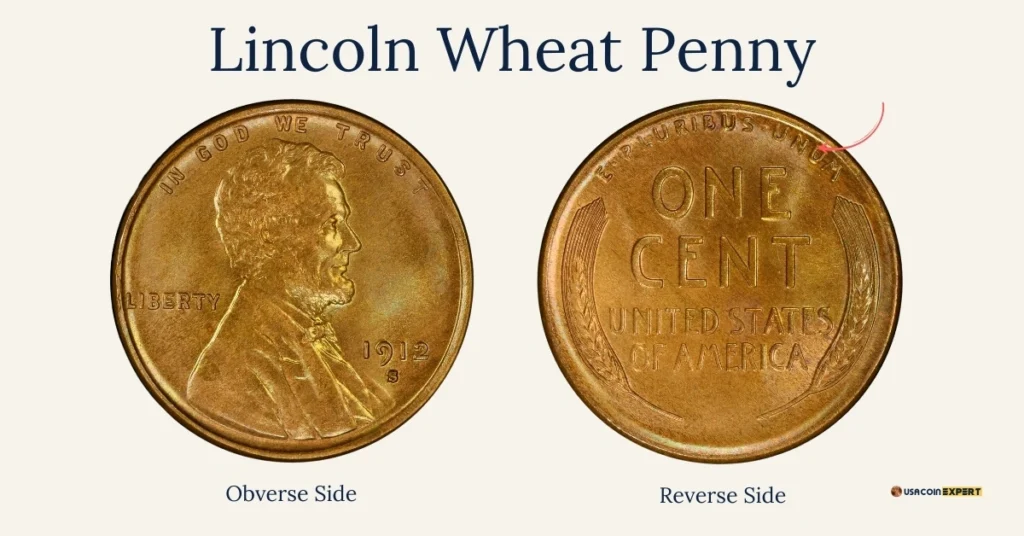
The Lincoln Wheat Penny is one of the most beloved coins among collectors. Introduced in 1909 to celebrate Abraham Lincoln’s centennial, this coin was groundbreaking as it was the first U.S. coin to feature a real historical figure rather than an allegorical image. Its design, history, and affordability make it a fantastic choice for new collectors.
Design Details
- Obverse Design (Front): The obverse features a detailed portrait of Abraham Lincoln, designed by sculptor Victor David Brenner. Lincoln is shown in profile, facing right, with his gaze calm and dignified—a fitting tribute to one of America’s most revered presidents. Brenner’s initials (“V.D.B.”) were initially placed on the reverse but later removed due to public backlash over their prominence.
- Reverse Design (Back): The reverse displays two wheat stalks, symbolizing prosperity and national unity. The words “ONE CENT” and “UNITED STATES OF AMERICA” are prominently displayed between the stalks, while the Latin motto “E PLURIBUS UNUM” arches above.
Historical Significance
The Lincoln Wheat Penny was introduced during a pivotal time in U.S. history. Its release marked the first time a president’s image appeared on American currency, breaking away from the classical imagery used in earlier designs. The coin celebrated 100 years since Lincoln’s birth, symbolizing his enduring legacy in shaping the nation.
Value Range
- Common Dates: Most Lincoln Wheat Pennies can be found for $0.10–$5 in circulated condition, making them affordable for beginners.
- Rare and High-Value Coins:
- 1909-S V.D.B.: The rarest of the series, with fewer than half a million minted. Values can exceed $500, even in circulated condition.
- 1914-D: Another rare coin, fetching prices upwards of $200–$400 depending on condition.
- 1922 (No D): A famous mint error, valued at $500+, even in worn condition.
Key Dates to Look For
- 1909-S: The first year of issue, with a low mintage of only 1.8 million coins.
- 1914-D: Known for its scarcity, with only 1.2 million minted.
- 1922 (No D): A fascinating error where the Denver mintmark was omitted, creating a highly collectible coin.
Why Collect Lincoln Wheat Pennies?
- Rich in History: These coins are a tangible connection to one of America’s most significant historical figures.
- Affordable and Accessible: Widely available and inexpensive, they’re perfect for building a robust collection on a budget.
- Fun to Hunt: Searching through old coin rolls or pocket change for key dates adds a sense of adventure to the hobby.
The Lincoln Wheat Penny is more than just a coin—it’s a piece of American history and a symbol of progress. Whether you’re intrigued by its design, rarity, or connection to Lincoln’s legacy, this coin is an essential starting point for any collection.
2. Jefferson Nickels: Affordable and Accessible

The Jefferson Nickel has been a staple of U.S. coinage since 1938, and its design has remained largely unchanged, making it a timeless addition to any collection. Featuring Thomas Jefferson on the obverse and his Virginia estate, Monticello, on the reverse, this coin reflects the ideals of leadership and legacy.
Design Details
- Obverse Design (Front): The obverse showcases a left-facing portrait of Thomas Jefferson, designed by sculptor Felix Schlag. Jefferson is portrayed with a dignified expression, embodying his role as a Founding Father and author of the Declaration of Independence.
- Reverse Design (Back): The reverse highlights Monticello, Jefferson’s iconic plantation home. Schlag’s design features fine architectural details, with the name “MONTICELLO” prominently displayed beneath the building, along with “UNITED STATES OF AMERICA.” The phrases “E PLURIBUS UNUM” and “FIVE CENTS” complete the design.
Historical Significance
The Jefferson Nickel was introduced in 1938, replacing the Buffalo Nickel. It debuted during a pivotal era of U.S. history, and its composition briefly changed during World War II (1942–1945) due to the need for nickel in wartime production. During this period, silver war nickels containing 35% silver were minted, making them unique among Jefferson Nickels and a favorite for collectors.
Value Range
- Common Dates: Most Jefferson Nickels are valued at $0.05–$10, depending on condition.
- Silver War Nickels: These nickels, minted from 1942 to 1945, contain 35% silver and have a melt value of around $1–$2, depending on silver prices.
- Rare Key Dates: Certain issues, such as the 1950-D, can fetch higher prices, often exceeding $15–$30.
Key Dates to Look For
- 1939-D and 1939-S: Early issues with lower mintages, making them sought-after coins.
- 1942–1945 (War Nickels): Easily identified by the large mintmarks (P, D, or S) placed above Monticello, these coins contain 35% silver and are historically significant.
- 1950-D: Known for its low mintage (just over 2.6 million), this is a standout key date in the series.
Why Collect Jefferson Nickels?
- Affordable and Abundant: Jefferson Nickels are commonly found in pocket change, bank rolls, and bulk coin lots.
- Historical Appeal: The wartime silver issues are unique and tie directly to a critical moment in U.S. history.
- Timeless Design: The coin’s consistent design makes it a long-standing symbol of American leadership and culture.
The Jefferson Nickel is a wonderful blend of history, affordability, and accessibility. Whether you’re drawn to its WWII-era silver coins or enjoy searching for rare dates, this series offers endless opportunities for new and seasoned collectors alike.
3. Roosevelt Dimes: Small but Mighty Collectibles

The Roosevelt Dime, first issued in 1946, is a tribute to President Franklin D. Roosevelt, a champion of the March of Dimes campaign to fight polio. This small coin packs a big punch in terms of affordability, historical significance, and collectibility, making it an excellent choice for new collectors.
Design Details
- Obverse Design (Front): The obverse features a profile portrait of Franklin D. Roosevelt, designed by sculptor John R. Sinnock. Roosevelt’s determined expression reflects his leadership during some of the nation’s most challenging times.
- Reverse Design (Back): The reverse showcases a torch, symbolizing liberty, flanked by an olive branch (peace) on the left and an oak branch (strength) on the right. The words “UNITED STATES OF AMERICA” and “ONE DIME” frame the design, with “E PLURIBUS UNUM” at the base.
Historical Significance
The Roosevelt Dime replaced the Mercury Dime in 1946, shortly after Roosevelt’s death. Its introduction honored his legacy, particularly his efforts in combating polio through the March of Dimes campaign. From 1946 to 1964, Roosevelt Dimes were minted in 90% silver, making these early coins particularly appealing to collectors for their intrinsic metal value.
Value Range
- Common Dates: Circulated Roosevelt Dimes from non-silver years (post-1964) are typically worth $0.10–$0.50, depending on condition.
- Silver Dimes (1946–1964): These dimes start at their melt value of around $2 and can go higher depending on condition and rarity.
- Scarce Key Dates: Certain low-mintage coins, such as the 1949-S and 1955-S, command premiums among collectors.
Key Dates to Look For
- 1949-S: A low-mintage silver dime with high collector demand.
- 1955-S: Scarce and valuable due to its limited production, making it a standout among silver Roosevelt Dimes.
Why Collect Roosevelt Dimes?
- Affordable: These coins are inexpensive, even in silver, making them accessible to collectors on any budget.
- Lightweight and Durable: Their small size and composition make them easy to store and handle.
- Silver and Historical Value: Early Roosevelt Dimes offer both numismatic and intrinsic metal value.
- Widely Available: They can often be found in coin shops, bulk lots, or even circulation for post-1964 examples.
The Roosevelt Dime combines practicality with historical importance. Whether you’re drawn to its connection to FDR’s legacy or the allure of silver coins, this series offers an affordable yet rewarding collecting experience.
4. Washington Quarters: Versatile and Popular
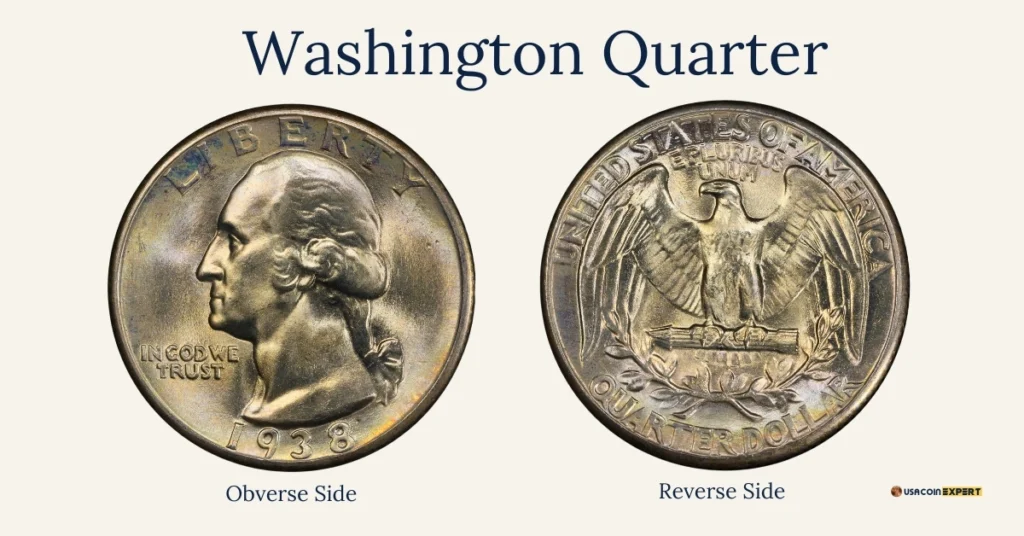
The Washington Quarter is one of the most enduring and versatile coins in U.S. history. First introduced in 1932 to commemorate the 200th anniversary of George Washington’s birth, this coin has evolved over the decades to feature an array of designs, making it both a historical and artistic centerpiece for collectors.
Design Details
- Obverse Design (Front): The obverse features a stately profile of George Washington, designed by sculptor John Flanagan. Washington is portrayed in a classic and dignified manner, facing left, with the inscriptions “LIBERTY” and “IN GOD WE TRUST” surrounding his profile.
- Reverse Design (Back): From 1932 to 1998, the reverse depicted an eagle perched on a bundle of arrows, with olive branches below, symbolizing strength and peace. After 1999, the series introduced the 50 State Quarters and later the America the Beautiful National Parks Quarters, showcasing unique designs for each state and national landmark.
Historical Significance
The Washington Quarter holds a special place in American history as it honors the founding father and first president of the United States. Its silver composition from 1932 to 1964 adds intrinsic value, while the post-1999 designs highlight the diverse cultural and natural heritage of the United States.
Value Range
- Common Dates: Circulated quarters from the non-silver era (post-1965) are worth face value ($0.25–$0.50).
- Silver Quarters (1932–1964): Valued primarily for their silver content, with melt values starting around $5.50, depending on silver prices.
- Rare and Key Dates: Coins like the 1932-D and 1932-S can fetch between $50 and $100+, even in lower grades.
Key Dates to Look For
- 1932-D and 1932-S:
- These inaugural-year coins had low mintages (just over 400,000 each) and are highly sought after by collectors.
- Silver Issues (1932–1964):
- Quarters from this period are 90% silver, adding intrinsic value and making them favorites among collectors.
Why Collect Washington Quarters?
- Affordable: Common dates are easy to find, and silver issues offer both collectible and intrinsic value.
- Diverse Designs: With the introduction of state and national park quarters, the series offers a wide variety of artistic and cultural designs to explore.
- Rich History: Collectors can trace American history through this coin, from honoring Washington to celebrating the nation’s landmarks.
- Easy to Find: These quarters are abundant in circulation, coin rolls, and coin shows, making them accessible to collectors of all levels.
The Washington Quarter is a versatile and rewarding series that combines history, artistry, and collectibility. Whether you’re hunting for early silver coins, key dates, or modern designs, this series has something to offer every collector.
5. Mercury Dimes: Beautiful and Affordable
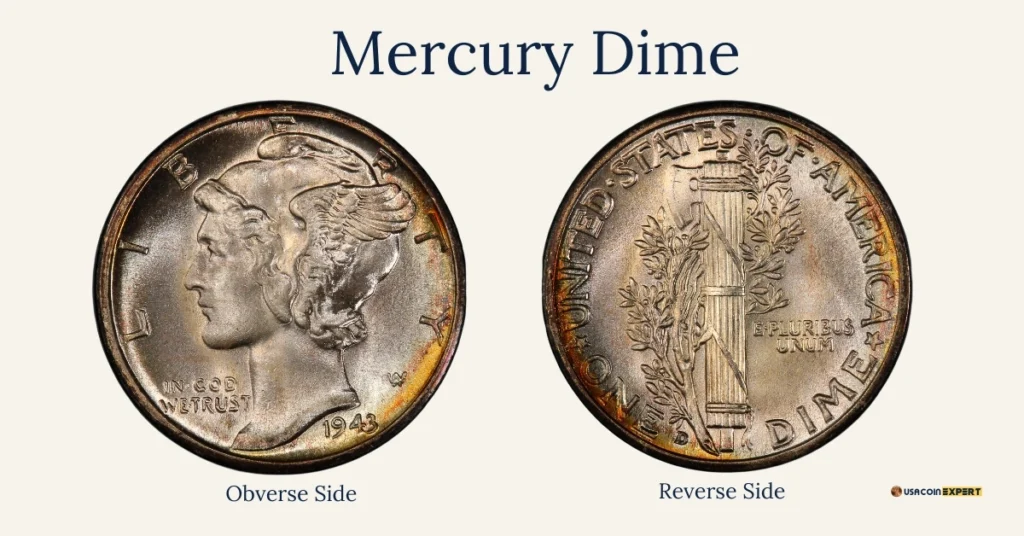
The Mercury Dime, minted from 1916 to 1945, is widely celebrated for its artistic beauty and timeless elegance. Officially named the “Winged Liberty Head Dime,” this coin earned its nickname due to the obverse design resembling the Roman god Mercury. Its combination of stunning craftsmanship, historical significance, and affordability makes it a favorite among collectors.
Design Details
- Obverse Design (Front): The obverse features a striking portrait of Liberty, adorned with a winged cap symbolizing freedom of thought. This design, created by sculptor Adolph A. Weinman, is often mistaken for the Roman god Mercury, giving the coin its nickname.
- Reverse Design (Back): The reverse showcases a fasces (a bundle of rods bound together with an axe), symbolizing strength and unity, flanked by an olive branch to represent peace. The inscription “E PLURIBUS UNUM” completes the design, highlighting the coin’s dual themes of strength and harmony.
Historical Significance
The Mercury Dime is a product of the early 20th-century Renaissance of American coinage, an era when artistic expression became a focal point in U.S. coin design. Minted entirely from 90% silver, these dimes reflect the economic and artistic values of their time, while also serving as tangible pieces of American history.
Value Range
- Common Dates: Most circulated Mercury Dimes are valued between $2 and $10, depending on condition.
- Scarce Examples: Uncirculated coins or those from key dates can fetch significantly higher prices, especially among collectors seeking to complete their sets.
Key Dates to Look For
- 1916-D:
- The rarest and most sought-after Mercury Dime, with a low mintage of just 264,000 coins. Its value often exceeds $1,000, even in lower grades.
- 1921 and 1921-D:
- These coins were minted in small quantities, making them scarce and highly collectible.
Why Collect Mercury Dimes?
- Historical Significance: These dimes embody the artistry and values of the early 20th century.
- Aesthetic Appeal: Known as one of the most beautiful U.S. coin designs, the Mercury Dime is a visual delight.
- Silver Content: Each coin contains 90% silver, adding intrinsic value and appeal to precious metal enthusiasts.
- Affordable and Accessible: Common dates are inexpensive and widely available, making them perfect for beginner collectors.
The Mercury Dime is a shining example of American artistry, history, and value. Whether you’re drawn to its stunning design or intrigued by its silver content, this coin is an essential addition to any collection.
6. Buffalo Nickels: Iconic American Design
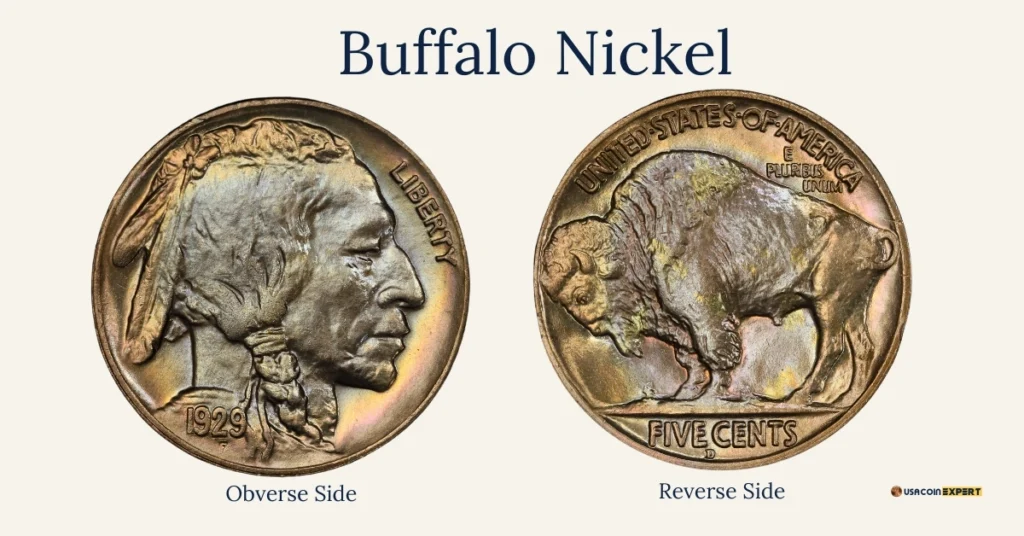
The Buffalo Nickel, minted from 1913 to 1938, is a cornerstone of American coinage and a favorite among collectors. Its bold design captures the spirit of the early 20th century, with a tribute to both Native American culture and the untamed American frontier. This coin’s striking imagery, historical significance, and affordability make it an essential addition to any collection.
Design Details
- Obverse Design (Front): The obverse features a proud Native American profile, designed by sculptor James Earle Fraser. The design was inspired by the facial features of multiple Native American leaders, creating a composite image that represents the dignity and resilience of Indigenous peoples.
- Reverse Design (Back): The reverse showcases a majestic American bison, commonly referred to as a buffalo. The animal stands on a grassy mound, symbolizing the rugged wilderness of the United States. Fraser is believed to have modeled the buffalo after Black Diamond, a bison from the Central Park Zoo in New York City.
Historical Significance
The Buffalo Nickel reflects the cultural and artistic movements of its time, emphasizing the nation’s frontier history and respect for Native American heritage. Its bold and unconventional design marked a departure from the more classical motifs of earlier U.S. coins, setting a new standard for artistic expression in coinage.
Value Range
- Common Dates: Circulated Buffalo Nickels typically range from $1 to $10, depending on condition and date.
- Scarce and Key Dates: Rare examples, such as mint errors or low-mintage coins, can fetch significantly higher prices.
Key Dates to Look For
- 1913-S (Type 2):
- A scarce variety featuring the revised reverse design with the buffalo standing on a flat line instead of a mound. This early issue is highly collectible.
- 1914-D:
- Known for its low mintage, this date commands high demand among collectors seeking to complete the series.
- 1937-D (3-Legged Buffalo):
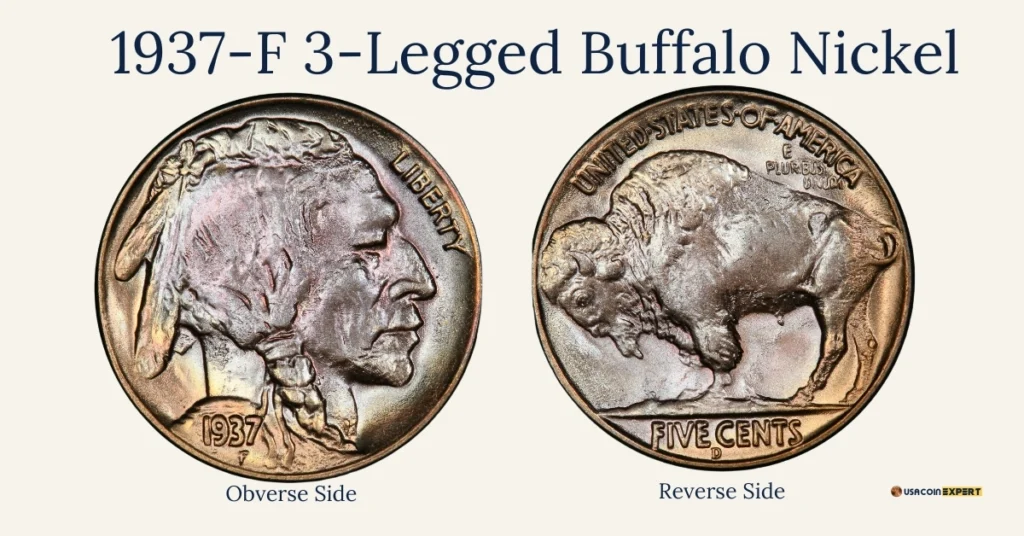
- One of the most famous mint errors in U.S. coinage, this coin features a buffalo with only three visible legs due to an over-polished die. It’s a must-have for collectors of rare and unusual coins.
Why Collect Buffalo Nickels?
- Rich in History: These nickels offer a tangible connection to America’s frontier past and Native American culture.
- Artistic Appeal: The bold and iconic design makes this coin a standout in any collection.
- Affordable: Common dates are budget-friendly, while rare issues provide exciting opportunities for advanced collectors.
- Widely Collected: The Buffalo Nickel’s enduring popularity ensures that it’s a staple of any numismatic collection.
The Buffalo Nickel is a celebration of American heritage, combining artistry and history in a way that few coins can match. Whether you’re drawn to its iconic design or enjoy hunting for rare varieties like the 3-Legged Buffalo, this series offers endless possibilities for collectors of all levels.
7. Indian Head Pennies: A Piece of 19th-Century History

The Indian Head Penny, minted from 1859 to 1909, is a cornerstone of American numismatics. Known for its intricate design and historical significance, this classic U.S. coin represents the industrial and cultural growth of the nation during the late 19th and early 20th centuries. Affordable and widely available, it’s a perfect addition for both novice and experienced collectors.
Design Details
- Obverse Design (Front): The obverse features Lady Liberty wearing a Native American headdress, designed by James B. Longacre. This unique depiction combines classical allegory with Native American iconography, symbolizing the unity and strength of the United States.
- Reverse Design (Back): The reverse displays a simple but elegant wreath design, which encircles the denomination “ONE CENT.” From 1860 onward, the wreath included a shield at the top, signifying national unity.
Historical Significance
The Indian Head Penny was introduced during a time of rapid industrialization and westward expansion in the United States. It became a mainstay in everyday commerce, circulating widely through an era that saw the Civil War, Reconstruction, and the dawn of the 20th century. Its design reflects a blend of classical and uniquely American influences, making it a piece of living history.
Value Range
- Common Dates: Indian Head Pennies from common years are valued between $2 and $10 in circulated condition, making them accessible to collectors on a budget.
- Scarce and Rare Coins: Coins from key dates or with low mintages can be significantly more valuable, especially in higher grades.
Key Dates to Look For
- 1877:
- The most coveted Indian Head Penny, with an extremely low mintage of just 852,500 coins. It’s considered a key date, valued at hundreds or even thousands of dollars in good condition.
- 1908-S and 1909-S:
- These were the first and only Indian Head Pennies to feature the San Francisco mintmark (S), making them scarce and highly desirable among collectors.
Why Collect Indian Head Pennies?
- Rich Historical Context: These coins serve as a tangible connection to a transformative period in U.S. history.
- Intricate Design: The detailed and unique artwork sets this series apart from other coins of its time.
- Affordable Options: Common dates are inexpensive and easy to find, making them a great starting point for new collectors.
- Challenging and Rewarding: Searching for rare dates like the 1877 issue or the 1909-S adds an element of excitement to your collection.
The Indian Head Penny is more than just a coin—it’s a piece of Americana that captures the essence of a pivotal era in U.S. history. Its beauty, affordability, and rich heritage make it an enduring favorite for collectors. Whether you’re starting with common dates or chasing after the rare 1877 issue, these pennies will add depth and character to your collection.
8. Morgan Silver Dollars (1878–1921) : Iconic and Timeless
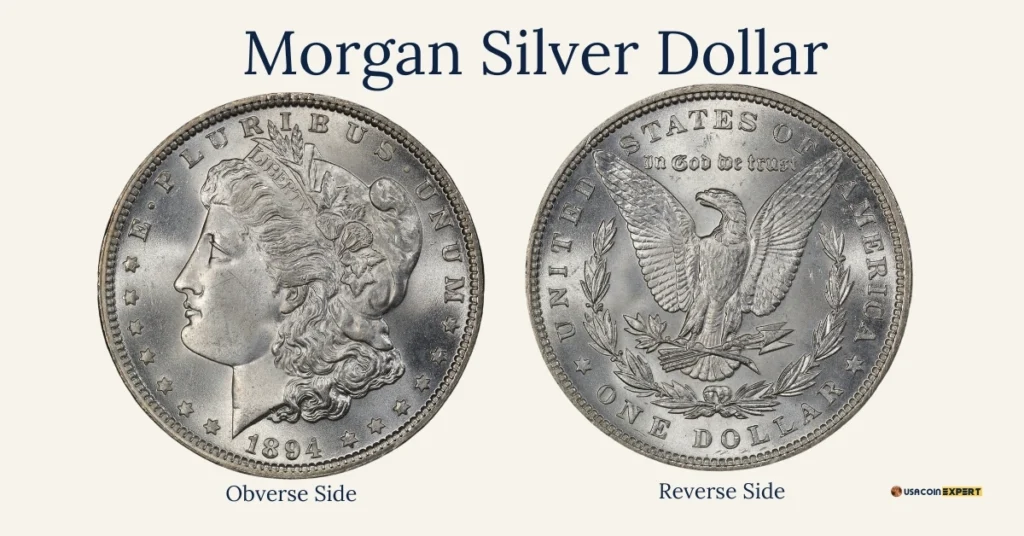
The Morgan Silver Dollar is one of the most beloved and iconic coins in U.S. history. Minted from 1878 to 1921, it embodies the prosperity and optimism of the late 19th century, often referred to as the Gilded Age. Known for its stunning design and 90% silver composition, this coin is a must-have for collectors.
Design Details
- Obverse Design (Front): The obverse features a profile of Lady Liberty, designed by George T. Morgan, after whom the coin is named. Liberty is depicted wearing a Phrygian cap, adorned with wheat and cotton—symbols of agriculture and industry. This blend of classical and American motifs reflects the era’s aspirations and ideals.
- Reverse Design (Back): The reverse showcases a majestic bald eagle with outstretched wings, clutching arrows and an olive branch in its talons. A wreath encircles the eagle, with the inscription “In God We Trust” prominently displayed above.
Historical Significance
The Morgan Silver Dollar was introduced following the Bland-Allison Act of 1878, which required the U.S. government to purchase large quantities of silver to mint coins. This act aimed to support the struggling silver mining industry in the western United States. The Morgan Dollar became a symbol of American prosperity and westward expansion, circulating widely during a time of rapid industrialization and economic growth.
Production ceased in 1904 but was briefly revived in 1921, marking the coin’s final year of minting.
Value Range
- Common Dates: Circulated Morgan Dollars from common years are typically valued between $25 and $40, depending on their condition and mintmark.
- Key Dates and Rare Coins:
- 1893-S: The rarest and most valuable Morgan Dollar, often worth thousands of dollars, even in lower grades.
- 1889-CC (Carson City): A highly sought-after coin due to its low mintage and historical significance.
- 1921 (High Relief): A unique design variation from the final year of production.
Why Collect Morgan Silver Dollars?
- Stunning Design: Considered one of the most beautiful coins in U.S. history, the Morgan Dollar is a masterpiece of numismatic artistry.
- Silver Content: Each coin contains 0.77344 troy ounces of silver, adding intrinsic value.
- Rich History: The coin represents a transformative era in American history, from westward expansion to industrialization.
- Variety for Collectors: With multiple mintmarks (e.g., Carson City “CC,” San Francisco “S”), rare dates, and condition variations, the series offers endless possibilities for collectors.
- Investment Potential: Morgan Dollars often retain or increase their value over time, making them appealing to investors and collectors alike.
The Morgan Silver Dollar is more than just a coin—it’s a piece of American heritage and a symbol of the nation’s industrial rise. Whether you’re drawn to its artistry, its silver content, or its historical significance, this timeless coin is an essential addition to any collection.
Expert Tips to Build Your Collection
Starting a coin collection is exciting, but it’s important to approach the hobby with the right tools and knowledge to make the most of your experience. Here are some expert tips to help you build a collection that’s both enjoyable and valuable.
1. Invest in the Right Tools
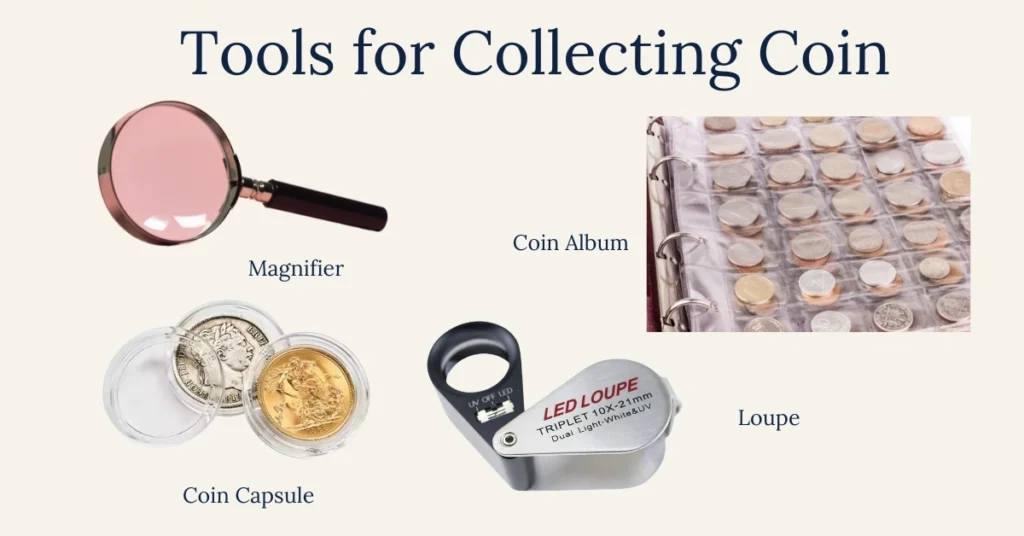
To get started, a few essential tools will help you organize and care for your coins:
- Magnifier: Use a high-quality magnifier or loupe to examine details, mintmarks, and conditions of coins more closely.
- Albums and Holders: Store your coins in protective albums, flips, or capsules to keep them safe from damage.
- Gloves: Wear soft cotton gloves when handling valuable coins to prevent oils or dirt from tarnishing them.
2. Learn About Coin Grading and Condition
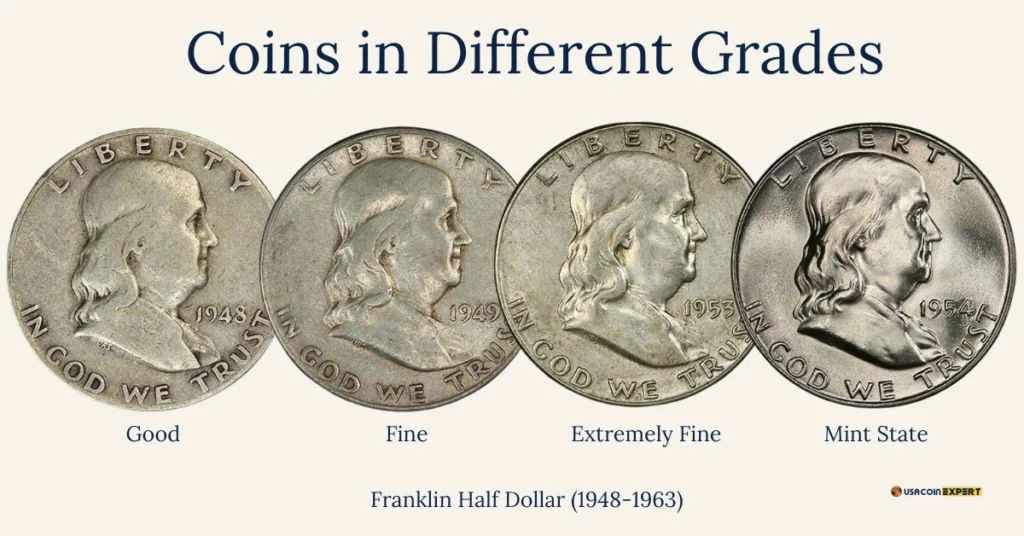
Understanding how coins are graded will help you determine their value and authenticity:
- Learn the basics of coin grading, which ranges from Poor (P-1) to Mint State (MS-70).
- Familiarize yourself with key grading factors, such as strike quality, luster, wear, and surface marks.
- Consider using a grading guidebook or online resources to evaluate your coins accurately.
3. Buy from Reputable Dealers or Trade with Other Collectors
When purchasing or trading coins, it’s essential to deal with trustworthy sources:
- Reputable Dealers: Look for dealers with good reviews and memberships in professional organizations like the American Numismatic Association (ANA).
- Coin Shows and Auctions: Attend local coin shows or online auctions to find unique coins and network with fellow collectors.
- Collector Communities: Join local coin clubs or online forums to trade coins and share insights with other enthusiasts.
4. Avoid Cleaning Coins
Cleaning coins may seem like a good idea, but it can significantly decrease their value:
- Cleaning can leave scratches, remove the natural patina, or damage the surface, which diminishes a coin’s appeal to collectors.
- If a coin is dirty, consult a professional numismatist for advice before attempting any cleaning.
5. Start Small and Set Goals
- Begin with coins that interest you, such as affordable series like Lincoln Wheat Pennies or State Quarters.
- Set collecting goals, such as completing a series, focusing on a specific country, or collecting coins by year.
- Enjoy the process and let your collection grow naturally over time.
Addressing Common Mistakes for Beginner Coin Collectors
Starting a coin collection can be exciting, but like any hobby, it’s easy to make mistakes that could lead to frustration or loss of value. To help you avoid these pitfalls, here are some common mistakes beginners often make.
1. Overpaying for Coins
It’s easy for beginners to overpay, especially when enthusiasm outpaces research.
- How to Avoid:
- Research the market value of coins before making a purchase. Use trusted resources like the Red Book (A Guide Book of United States Coins) or online price guides.
- Compare prices from multiple sources, including local dealers, online marketplaces, and coin shows.
- Beware of emotional buying—stick to your budget and collecting goals.
2. Buying Counterfeits
Counterfeit coins can fool even seasoned collectors, and beginners are especially vulnerable.
- How to Avoid:
- Purchase coins only from reputable dealers or sellers with a proven track record. Look for dealers who are members of organizations like the American Numismatic Association (ANA).
- Learn to spot red flags, such as unusually low prices for high-value coins or lack of proper documentation.
- Educate yourself on common counterfeit tactics, like altered mintmarks or coins struck from molds rather than official dies.
- When in doubt, have coins authenticated by professional grading services like NGC or PCGS.
3. Neglecting Proper Storage
Coins are delicate and can easily be damaged by improper handling or storage, reducing their value and appeal.
- How to Avoid:
- Store your coins in a controlled environment away from excessive humidity, heat, or direct sunlight. These conditions can cause tarnishing or corrosion.
- Use proper storage solutions, such as coin albums, flips, or capsules, to protect coins from dust, oils, and scratches.
- Avoid touching coins with bare hands—use cotton gloves to handle them and hold coins only by their edges.
- Keep your collection organized, and consider labeling coins with details like date, mintmark, and grade.
4. Cleaning Coins
Cleaning coins is one of the biggest mistakes new collectors make, as it can significantly reduce their value.
- Why Cleaning is Harmful: Cleaning often leaves scratches, removes natural patina, and diminishes a coin’s historical appeal.
- What to Do Instead: If a coin appears dirty, leave it as is. The natural wear and toning add to its authenticity and collector value. If absolutely necessary, consult a professional numismatist for proper cleaning methods.
5. Lack of Focus or Goals
Jumping into coin collecting without a plan can lead to an unfocused collection or wasted resources.
- How to Avoid:
- Set specific goals, such as completing a series, focusing on a particular time period, or collecting coins with a specific theme.
- Start with affordable coins and expand your collection as you learn more about the hobby.
Budget Tips for New Collectors
Starting a coin collection doesn’t have to be expensive. With the right strategies, you can build an impressive collection without breaking the bank. Here are some practical tips to help you collect on a budget while still enjoying the thrill of finding unique and valuable coins.
1. Where to Find Affordable Coins
Affordable coins are all around you if you know where to look. Here are some of the best places to start:
- Bank Rolls: Visit your local bank and request rolls of pennies, nickels, or quarters. Sorting through these rolls can uncover hidden treasures like old Wheat Pennies, silver coins, or error coins.
- Estate Sales and Garage Sales: These are great places to find coin collections being sold at reasonable prices. Often, the seller is looking to declutter and may not be aware of the value of certain coins.
- Flea Markets and Antique Shops: Vendors at these locations often sell mixed lots of coins at low prices. Take your time to inspect and identify interesting finds.
- Bulk Coin Lots: Online platforms like eBay or coin dealer websites often offer bulk lots of foreign or domestic coins. These lots can yield a mix of common and uncommon coins at an affordable price.
- Pocket Change: Don’t underestimate the coins in your own pocket! Many collectible coins, like Lincoln Wheat Pennies or State Quarters, still circulate and can be found in your daily change.
2. Prioritize Your Purchases
When working within a budget, it’s essential to focus on coins that provide the best value for your money:
- Start with Circulated Coins: Circulated coins are more affordable than their uncirculated counterparts. For example, a circulated Lincoln Wheat Penny may cost just a few cents, while a pristine uncirculated one can cost significantly more.
- Complete Common Sets First: Begin with affordable sets, such as Lincoln Wheat Pennies, Jefferson Nickels, or State Quarters. Completing these series can be both rewarding and budget-friendly.
- Focus on Quality Over Quantity: Instead of buying large quantities of low-value coins, focus on acquiring fewer coins in better condition. A well-preserved coin holds more long-term value and appeal.
- Set Goals: Define your collecting focus early. Whether you’re collecting by date, mintmark, or design theme, having a goal helps you allocate your budget more effectively.
3. Use Tools to Maximize Value
A little knowledge and preparation can go a long way toward stretching your budget:
- Invest in a Guidebook: A guide like A Guide Book of United States Coins (The Red Book) provides detailed price ranges for coins and helps you spot deals.
- Learn to Spot Value: Familiarize yourself with grading and key identifiers, such as rare mintmarks or historical significance, so you can recognize undervalued coins when you see them.
- Be Patient: Good deals take time. Don’t rush into purchases; wait for coins that meet both your goals and budget.
4. Network with Other Collectors
Building relationships with other collectors can help you find affordable coins and trade for pieces you need:
- Local Coin Clubs: Joining a coin club is an excellent way to connect with experienced collectors who may sell or trade coins at reasonable prices.
- Online Communities: Platforms like Reddit, Facebook groups, or coin-collecting forums often have buy/sell/trade sections for budget-conscious collectors.
5. Avoid Impulse Buying
While it’s tempting to buy a coin as soon as you spot it, impulsive purchases can lead to overspending.
- Stick to your collecting plan and budget.
- Always compare prices before buying.
- Avoid paying premiums for coins you can find more affordably elsewhere.
Conclusion
Coin collecting is more than just a hobby—it’s an adventure through history, culture, and art. Whether you’re discovering the rich legacy of Lincoln Wheat Pennies, marveling at the intricate beauty of Mercury Dimes, or exploring the global stories behind foreign coins, each piece you collect adds a new layer to your journey.
The best part? Coin collecting is accessible to everyone. With affordable options, simple tools, and a bit of knowledge, you can build a collection that’s both meaningful and rewarding. By starting small, setting clear goals, and avoiding common mistakes, you’ll develop the skills and confidence to enjoy this timeless pastime.
As you embark on your collecting journey, remember that it’s not just about the coins themselves—it’s about the stories they tell, the memories you create, and the connections you make along the way. So grab your magnifier, start hunting for treasures, and let your collection grow, one coin at a time. Happy collecting!
FAQ: Frequently Asked Questions About Coin Collecting
1. What makes a coin valuable?
Several factors determine a coin’s value, including:
Rarity: Coins with low mintage or limited production are more valuable.
Condition: The better the coin’s condition (less wear), the higher its value.
Historical Significance: Coins tied to important events or eras tend to be more sought after.
Metal Content: Coins made from silver, gold, or other precious metals have intrinsic value based on their metal content.
2. Where can I find affordable coins for my collection?
You can find affordable coins in several places, such as:
Bank rolls and pocket change.
Estate sales, garage sales, and flea markets.
Bulk lots from online marketplaces like eBay.
Local coin shops and shows.
3. Should I clean my coins?
No, cleaning coins is not recommended as it can damage their surface, remove natural patina, and significantly decrease their value. If a coin is dirty, consult a professional numismatist before attempting any cleaning.
4. What tools do I need to start coin collecting?
Beginner collectors should have these essential tools:
A magnifier or loupe for inspecting details.
Coin albums, flips, or capsules for safe storage.
Cotton gloves to handle coins without leaving fingerprints.
A coin guidebook like the Red Book for pricing and grading information.
5. How do I identify a rare coin?
Look for these key indicators:
Mintmarks: Certain mintmarks, like “D” (Denver) or “S” (San Francisco), indicate rarer coins.
Key Dates: Research specific years or varieties that are known to be rare (e.g., 1909-S V.D.B. Wheat Penny).
Errors or Varieties: Coins with mistakes, such as misstruck designs or missing elements, are often highly collectible.
6. What are the best coins for beginners to collect?
Some great coins for beginners include:
Lincoln Wheat Pennies (1909–1958): Affordable and rich in history.
Jefferson Nickels (1938–Present): Accessible and varied.
Roosevelt Dimes (1946–Present): Affordable, with silver options for early years.
State Quarters (1999–2008): Modern coins with diverse designs.
7. How do I store my coins properly?
Store your coins in a cool, dry place away from humidity and direct sunlight. Use albums, flips, or capsules to protect them from dust, scratches, and environmental damage. Avoid handling coins with bare hands; use gloves to preserve their condition.
8. How do I get coins authenticated or graded?
Submit your coins to professional grading services like PCGS (Professional Coin Grading Service) or NGC (Numismatic Guaranty Corporation). These organizations evaluate a coin’s authenticity and condition, providing it with an official grade.
9. Can coin collecting be a good investment?
While coin collecting is primarily a hobby, certain coins can appreciate in value over time, especially rare or precious metal coins. However, it’s important to collect for enjoyment rather than solely for profit, as market trends can vary.
10. What is the best way to learn more about coin collecting?
Read books like A Guide Book of United States Coins by R.S. Yeoman.
Join local coin clubs or online communities to connect with other collectors.
Attend coin shows and auctions to gain hands-on experience.
Use online resources, such as the American Numismatic Association (ANA) website or coin forums.



